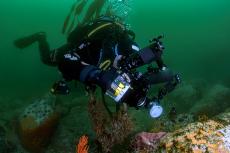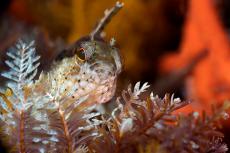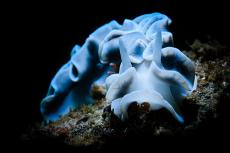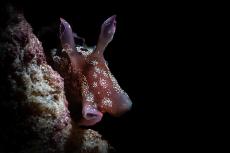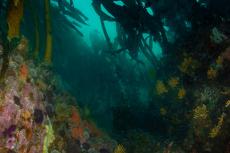Cape Town: Underwater Photography Off South Africa's Rugged Scenic Coast
Cape Town is a cosmopolitan, vibrant and modern city. Renowned for its beautiful landmarks of Table Mountain and the Cape Peninsula, Cape Town is a popular destination for divers who come to explore her colourful kelp forests, historic wrecks and glittering reefs.
Blue and yellow gasflame nudibranch, one of the most popular subjects in Cape Town, South Africa. Photo by Kate Jonker.
Tags & Taxonomy
The beauty of Cape Town stretches beyond the shoreline and beneath the waves, providing divers and underwater photographers a lively and fascinating playground with a beautiful backdrop to match.
There are three main dive areas in Cape Town. Although this is a year-round diving destination, the sea conditions are greatly affected by the wind and weather patterns. Where you dive will depend on the time of year you visit.
Gordon’s Bay (Eastern False Bay)
—Summer diving (October to May)
Gordon’s Bay, along the eastern side of False Bay, boasts some of the most beautiful and varied dive sites in Cape Town. The topography differs according to dive site and the pristine reefs range from steep sided, ragged walls starting at 15m, dropping straight down to 30m, to shallower reefs and kelp forests with average depths of 15m.
This is a mecca for macro photographers, with an abundance of nudibranchs, spider crabs, cuttlefish, octopus, pipefish, small colourful klipfish and rocksuckers. Smaller shark species include pyjama shark, puffadder shyshark and leopard catshark as well as gully sharks. Schools of fish hover above the vibrant reefs, which are densely covered with marine life, colourful soft corals, huge sea fans, feather stars and anemones. There are also a number of kelp forests where divers can sometimes encounter huge stingrays, gully sharks and sevengill cow sharks. Divers are often joined by playful and inquisitive Cape fur seals on their dives here.
Simon’s Town (Western False Bay)
—Winter diving (May to September)
The reefs along the western (Simon’s Town) side of False Bay comprise primarily of huge granite boulders and scattered granite rocks surrounded by coarse sand. A number of the dive sites have beautiful swim-throughs to explore. There are dive sites suitable for both Open Water and Advanced divers.
On the reefs, you will find sea fans, soft corals, sponges and feather stars. Many of the dive sites are situated within a marine protected area and the fish life is plentiful and varied. It is quite normal to see the smaller shark species on dives here, including pyjama sharks, puffadder shysharks and gully sharks. Macro life includes numerous species of nudibranchs, crabs, octopus and cuttlefish.
Atlantic Coastline
—Summer diving (October to May)
The Atlantic coastline is known for its huge granite boulders and granite bedrock covered with invertebrates and plant life, colourful sponges, soft corals, sea fans, nudibranchs, crabs and basket stars. Divers also have the opportunity to snorkel with and photograph the playful and inquisitive seals at Duiker Island at the entrance to Hout Bay and explore a number of wrecks in and around Hout Bay.
What to wear
Water temperatures differ from area to area, and as the water along the Atlantic coastline is brought in from the Antarctic by the cold Benguela Current, the water is chilly and temperatures usually range between 8°C and 13°C. The water in False Bay is much warmer and temperatures along the Simon’s Town and Gordon’s Bay coastlines average between 12°C and 15°C, reaching 19°C in summer.
To remain comfortable whilst diving any of the areas in Cape Town, a 7mm wetsuit or semi-drysuit, or a 5mm with chicken vest along with booties, hood and gloves are advised. If you own a drysuit and are able to travel with the additional weight, you could be better off bringing that and adjusting your undergarments accordingly. Also, as you will be wearing booties, open-heeled fins will be required. A dive computer, torch and deployable or delayed surface marker buoy with reel are also recommended for all divers.
The diving
Most diving is done from 8m-long rubber ducks, known as RIBs or zodiacs in other parts of the world. The standard procedure is for divers to put their gear together on land, after which it is loaded onto the boat where the skipper will secure it to dive racks. It is best to pack your camera into a soft cooler bag as most dive operators do not have space on the boats for large camera boxes, nor do they provide special racks for cameras. Affordable cooler bags can be purchased at most of the larger supermarkets once you arrive.
When ready to launch, divers don wetsuits and booties and climb on board. Most boats launch from either the Simon’s Town, Hout Bay or Gordon’s Bay harbours. Once at the dive site, the divers kit up for the dive, usually with the assistance of a dive guide or the skipper. When everyone is ready to enter the water, the skipper will slowly count “one, two, three, go!” and the divers all roll backwards into the water at the same time, on the word “go.” It is best to roll backwards with your camera tucked tightly to your chest. Some skippers are happy to pass you your camera, but this can be a problem if there is a surface current running or if there are a number of photographers all needing their cameras to be passed to them!
Divers can usually choose to dive with a dive guide or in buddy pairs without a guide, exploring the reefs at their own pace. This is a suitable arrangement for photographers and more experienced divers who want to take their time instead of rushing to keep up with the dive guide. At the end of the dive, buddy pairs deploy their surface marker buoys, and the dive boat will come to pick them up. It is therefore important for all divers to have their own dive computers and surface marker buoys with them on every dive. Dives tend to be limited by bottom time or a maximum of 60 minutes, whichever comes first.
Underwater photography
Underwater photographers are normally well looked after as most skippers and boat crew are used to handling cameras and underwater photography equipment. I would advise doing a bit of homework beforehand to ensure you choose a dive centre that is “photographer friendly” and fits your style of diving. They will not allow you to dive on your own, but many operators have dive guides or in-house photographers who will buddy up with you and help seek out those critters you want to photograph.
As conditions can change from one day to the next, it is worth contacting your dive centre the day before you dive to find out what they expect the sea conditions and visibility to be like. Visibility is very variable and can range from 5m to 20m at any time of the year. When in doubt, however, go macro, as you will always find many intriguing macro subjects to photograph on all your dives.
Macro photography
There are many colourful and fascinating macro subjects to photograph in Cape Town’s nutrient-rich waters. Macro life is plentiful and incredibly diverse, with a large number of endemic species. Underwater photographers will be kept busy an entire dive with the numerous critters that can be found on the reefs, and will likely find themselves wanting to do more and more macro photography whilst diving Cape Town’s luxuriant reefs.
For nudibranch fanatics, “nudis” can be found everywhere. They range in size from just a few millimetres to just over 10cm in length. Most famous are the beautiful blue and yellow gasflame nudibranchs, inkspot nudibranchs, Cape dorids, frilly nudibranchs, coral nudibranchs, purple ladies and whip fan nudibranchs. There is even a nudibranch called the Mandela nudibranch that can be found on some reefs, most notably at Steenbras Deep in Gordon’s Bay. The best dive sites for nudibranchs include Steenbras Deep, Sterretjies, Blousteen and Stone Dog in Gordon’s Bay as well as Photographer’s Reef, A-Frame and Roman Rock in Simon’s Town.
Other macro life includes pipefish, spider crabs, common and bobtail cuttlefish, octopus, sea spiders, flatworms, strawberry anemones, feather stars, amphipods, tubular hydroids, basket stars and quirky little fish such as tiny smoothskin scorpionfish, rocksuckers (which are all head and no body!), blennies and Cape triplefins as well as the many colourful and inquisitive species of klipfish. The strange and unusual horsefish and white sea catfish can also be spotted on deeper reefs such as Steenbras Deep and Drop Zone in Gordon’s Bay as well as at Whittle Rock in Simon’s Town.
For Canon or Nikon crop sensor shooters, a 60mm macro is a great option and easier to use in occasional surge and low-visibility conditions. This, paired with a wet diopter that fits in front of your port, should have you covered for anything you might encounter on a macro dive. For full-frame cameras, a 100mm (Canon) and 105mm (Nikon) lens will be perfect, along with a wet diopter for smaller critters.
Wide-angle photography
Many of the reefs have fantastic topography well suited for wide angle photography. Most reefs are covered in colourful marine life, anemones, sponges and soft corals in beautiful pinks, purples, yellows and oranges. Orange sea fans add to the riot of colour on the reefs, which contrasts beautifully against the green, temperate waters. Reefs well worth visiting include Atlantis, Photographer’s Reef and Whittle Rock in Simon’s Town; Steenbras Deep, Sterretjies and Rooi Els in Gordon’s Bay; and Star Walls in Hout Bay.
The wrecks of Smitswinkel Bay in Simon’s Town and in Hout Bay provide those with a lust for rust the chance to explore and photograph unique wrecks, many of which are covered in colourful soft corals, sponges and anemones. They also attract schools of fish, providing a confetti of silver glitter against the hulks of the wrecks themselves.
There are also numerous kelp forests to explore and these provide remarkable wide-angle opportunities. The forests are home to many fish species, rays, smaller sharks and seals. The reefs upon which the kelp forests grow are covered with vibrant jewel-like anemones, starfish, sea urchins, sponges and feather stars. There is nothing more beautiful than photographing the sun’s rays as they filter through the kelp fronds, lighting up the reef below. Many of the reefs such as Pyramid Rock, Castle Rock and A-Frame in Simon’s Town and Blousteen and Rooi Els in Gordon’s Bay provide incredible kelp forest dives.
Cape Town’s reefs are also perfect for wide-angle macro or close focus wide-angle photography as the vibrant reefs, colourful sea fans, basket stars, anemones and reef dwelling fish as well as larger nudibranchs present beautiful foreground subjects with the rugged topography and green water background perfecting the image.
Cape fur seals
A trip to Cape Town would not be complete without a snorkel or a dive with the Cape fur seals. They are playful and inquisitive and a lot of fun to photograph. The best dive sites to see these “puppies of the sea” are Partridge Point in Simon’s Town and Duiker Island in Hout Bay. Seals are plentiful in Cape Town and it is not unusual to have seals swoop down and inspect you at any of the dive sites in Simon’s Town, Gordon’s Bay or Hout Bay.
Blue and mako sharks
Dives “into the blue” to see the blue sharks and makos are very exciting. The dive boats take divers out to the edge of the warm Agulhas Current, some 20 nautical miles off Cape Point. This warmer water tends to be clearer and bluer, providing a wonderful blue backdrop to the sharks one can encounter out there.
Wide-angle tips
My favourite lens for wide-angle in Cape Town is my Tokina 10 – 17mm fish-eye behind a mini dome port, which allows me to switch between wide-angle and close focus wide-angle or wide-angle macro; or behind a large dome port for wide-angle as well as half-and-half shots on the same dive. With wide-angle, it is best to use what you are used to and what is easiest for you to travel with.
Recommended accessories
- • A focus light is strongly recommended to help with focussing as the deeper reefs can sometimes be dark, especially in winter when there is a cloud cover.
- • Snoots are also a lot of fun and can help isolate your subjects from the very busy and vibrant reefs and really make them “pop”!
- • A pointer or muck stick is also useful to steady yourself on the reef if there are surge conditions.
- • Wet diopters for macro photography are also useful to help magnify your subjects as some of the critters can be smaller than 1cm in length.
Compact camera users have the luxury of adding a wet diopter or wide-angle wet lens to their housings and have the best of both worlds on any dive!
Having travelled to many destinations across the globe, I always look forward to diving in Cape Town. With year round diving—whether it be kelp forests, reefs or wrecks, shallow or deep, wide-angle or macro—there is something for everyone in this beautiful underwater paradise! ■
Kate Jonker is an underwater photographer and dive writer, underwater photography instructor, dive guide and dive boat skipper based in South Africa who leads dive trips across the globe. For more information regarding diving and underwater photography in Cape Town, divers are welcome to find her at: katejonker.com.
Download the full article ⬇︎





